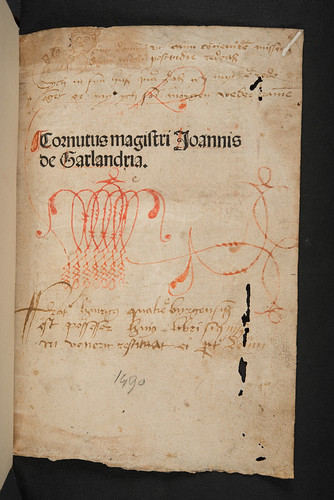Garlandia, Johannes de: Cornutus cum commento.
With Cornutus novus by Otto de Lunenborch.
Hagenau: Heinrich Gran, 1489.
4to. A-F8.6 G-H8 χ6. A1 unsigned, A2 signed "Ai", etc. The first four leaves of the quire represented by χ are numbered but not signed. [64] leaves, 2-58 numbered "Folium Primū." – "Folium Quinquageſimū ſeptimū."
ISTC ig00082000; GW M13726; Goff G82; BMC III 681 (IA. 13703); Bod-inc G-039; CIBN J-226; BSB-Ink I-414.
| GIP number: | G6 |
| Shelf-mark: | Sp Coll BC14-a.1 (see main library entry for this item) |
| Note: | Blind impressions of lines of type visible on H8v. |
| Bound with: | The first of six incunabula bound together. Bound with: (2) Garlandia, Johannes de, Synonyma. Reutlingen: [Michael Greyff], 1487 (G8); (3) Samuel de Monte Rutilo, Synonyma partium indeclinabilium. [Speyer: Johann and Conrad Hist, not after 1490] (S10); (4) Garlandia, Johannes de, Nomina et verba defectiva. [Mainz: Peter von Friedberg, ca. 1493] (G7); (5) Garlandia, Johannes de [pseudo-], Composita verborum. Strassburg: [Johann Prüss], 1490 (G11); (6) Garlandia, Johannes de, Verba deponentalia. [Lübeck: Printer of the Breviarium Lubucense (GW5376), ca. 1490] (G9). |
| Provenance: | Frater Hinricus (16th century), of Aywaille(?), Liège: inscription on A1r “Frat[er] hinric[us] aqualiae(?) burgensis est possessor hui[us] libri si quis invenerit restituat ei p[ropter] deum”; a similar inscription (scored through) on front pastedown. Johann Christian Schöttgen (1687-1751), biblical scholar: engraved bookplate “Christianus Schoettgenius” with palm tree and motto “Justus ceu palma virebit” remounted on new rear pastedown. Sir William Hamilton (1788-1856), Professor of Logic and Metaphysics, University of Edinburgh: source unknown. University of Glasgow: Hamilton collection donation, 1878. |
| Binding: | 16th-century blind-tooled calf. The front cover is decorated with fillets to form four concentric rectangles: the inner rectangle is decorated with three vertical lines of a repeated foliate stamp; the second rectangle is undecorated; the third rectangle is decorated with a foliate roll; and the outer rectangle is decorated with a roll of rope-like pattern and with separate foliate stamps. The rear cover is likewise divided into four concentric rectangles: the inner rectangle is decorated with a repeated vine-like tool with tendrils (Rautengerank) to form characteristic pointed oval shapes, each filled with a separate fringed foliage ornament; the second rectangle is undecorated (though with some overlap on two sides from the ornament of the inner rectangle); the third rectangle is decorated with a foliate roll; the outer rectangle is decorated with a stamp of a five-petalled flower. Two brass clasps (one lost), catch plates on front board. Grey paper tabs separate each work. Restored and rebacked c.1985 by Ian Maver (restoration binder, Special Collections Department, Glasgow University Library) and given new endpapers and flyleaves; original spine covering lost; original front pastedown put back. Size: 216 × 147 mm. |
| Leaf size: | 200 x 136 mm. |
| Annotations: | On A1r is a quotation, in a 16th-century hand, from Nicolaus Perottus, Rudimenta grammatices: “Cum domum ut eum co[n]uenire[m] iuissem dixit mihi postridie redeas” (see Rudimenta grammatices. Edited by W. Keith Percival, electronic ed., 2010, ch. 1256, p. 280), which is followed by a version in Netherlandish dialect(?); single marginal annotation on A3v “Explicatio tituli”; interlinear numeration in some of the early chapter headings; on the front pastedown, in a 16th-century hand, are quotations copied from the commentary by Johannes Synthen contained in the fifth work in this volume. |
| Decoration: | Pen-and-ink drawing of a face in brown ink on A1r, together with calligraphic pen-work (a monogram?) in red ink; on A1v is a drawing in red ink of the head of a mythical beast surrounded by red pen-work; six-line initial “A” on A2r supplied in red and reserved white with marginal flourishes; two-line initial “C” on A4r supplied in red with flourishes; paragraph marks supplied in red throughout. |
| Imperfections: | Ten leaves (E8, F1-6, G1-3) torn out - stubs visible; geometrical marginal excisions on H7 and H8. |





